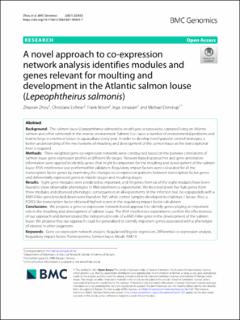| dc.contributor.author | Zhou, Zhaoran | |
| dc.contributor.author | Eichner, Christiane | |
| dc.contributor.author | Nilsen, Frank | |
| dc.contributor.author | Jonassen, Inge | |
| dc.contributor.author | Dondrup, Michael | |
| dc.date.accessioned | 2022-02-07T07:43:46Z | |
| dc.date.available | 2022-02-07T07:43:46Z | |
| dc.date.created | 2021-12-02T16:25:05Z | |
| dc.date.issued | 2021 | |
| dc.identifier.issn | 1471-2164 | |
| dc.identifier.uri | https://hdl.handle.net/11250/2977353 | |
| dc.description.abstract | Background
The salmon louse (Lepeophtheirus salmonis) is an obligate ectoparasitic copepod living on Atlantic salmon and other salmonids in the marine environment. Salmon lice cause a number of environmental problems and lead to large economical losses in aquaculture every year. In order to develop novel parasite control strategies, a better understanding of the mechanisms of moulting and development of the salmon louse at the transcriptional level is required.
Methods
Three weighted gene co-expression networks were constructed based on the pairwise correlations of salmon louse gene expression profiles at different life stages. Network-based approaches and gene annotation information were applied to identify genes that might be important for the moulting and development of the salmon louse. RNA interference was performed for validation. Regulatory impact factors were calculated for all the transcription factor genes by examining the changes in co-expression patterns between transcription factor genes and deferentially expressed genes in middle stages and moulting stages.
Results
Eight gene modules were predicted as important, and 10 genes from six of the eight modules have been found to show observable phenotypes in RNA interference experiments. We knocked down five hub genes from three modules and observed phenotypic consequences in all experiments. In the infection trial, no copepodids with a RAB1A-like gene knocked down were found on fish, while control samples developed to chalimus-1 larvae. Also, a FOXO-like transcription factor obtained highest scores in the regulatory impact factor calculation.
Conclusions
We propose a gene co-expression network-based approach to identify genes playing an important role in the moulting and development of salmon louse. The RNA interference experiments confirm the effectiveness of our approach and demonstrated the indispensable role of a RAB1A-like gene in the development of the salmon louse. We propose that our approach could be generalized to identify important genes associated with a phenotype of interest in other organisms. | en_US |
| dc.language.iso | eng | en_US |
| dc.publisher | BMC | en_US |
| dc.rights | Navngivelse 4.0 Internasjonal | * |
| dc.rights.uri | http://creativecommons.org/licenses/by/4.0/deed.no | * |
| dc.title | A novel approach to co-expression network analysis identifies modules and genes relevant for moulting and development in the Atlantic salmon louse (Lepeophtheirus salmonis) | en_US |
| dc.type | Journal article | en_US |
| dc.type | Peer reviewed | en_US |
| dc.description.version | publishedVersion | en_US |
| dc.rights.holder | Copyright The Author(s), 2021 | en_US |
| dc.source.articlenumber | 832 | en_US |
| cristin.ispublished | true | |
| cristin.fulltext | original | |
| cristin.qualitycode | 1 | |
| dc.identifier.doi | 10.1186/s12864-021-08054-7 | |
| dc.identifier.cristin | 1963735 | |
| dc.source.journal | BMC Genomics | en_US |
| dc.identifier.citation | BMC Genomics. 2021, 22, 832. | en_US |
| dc.source.volume | 22 | en_US |

